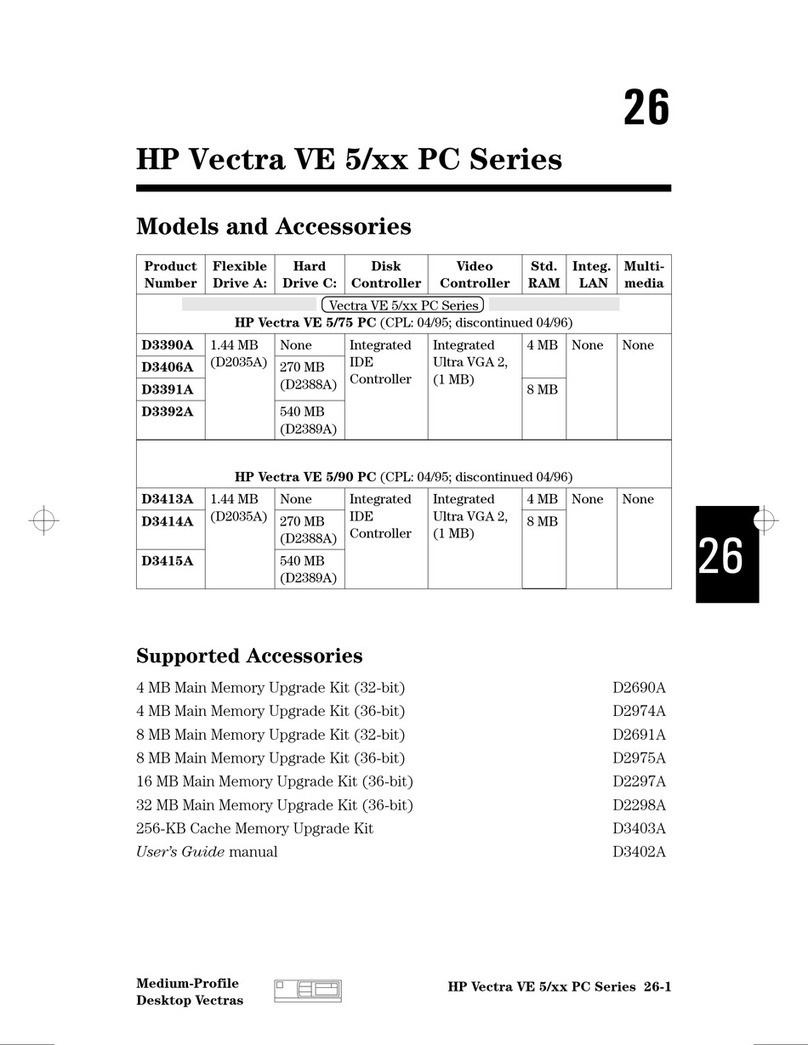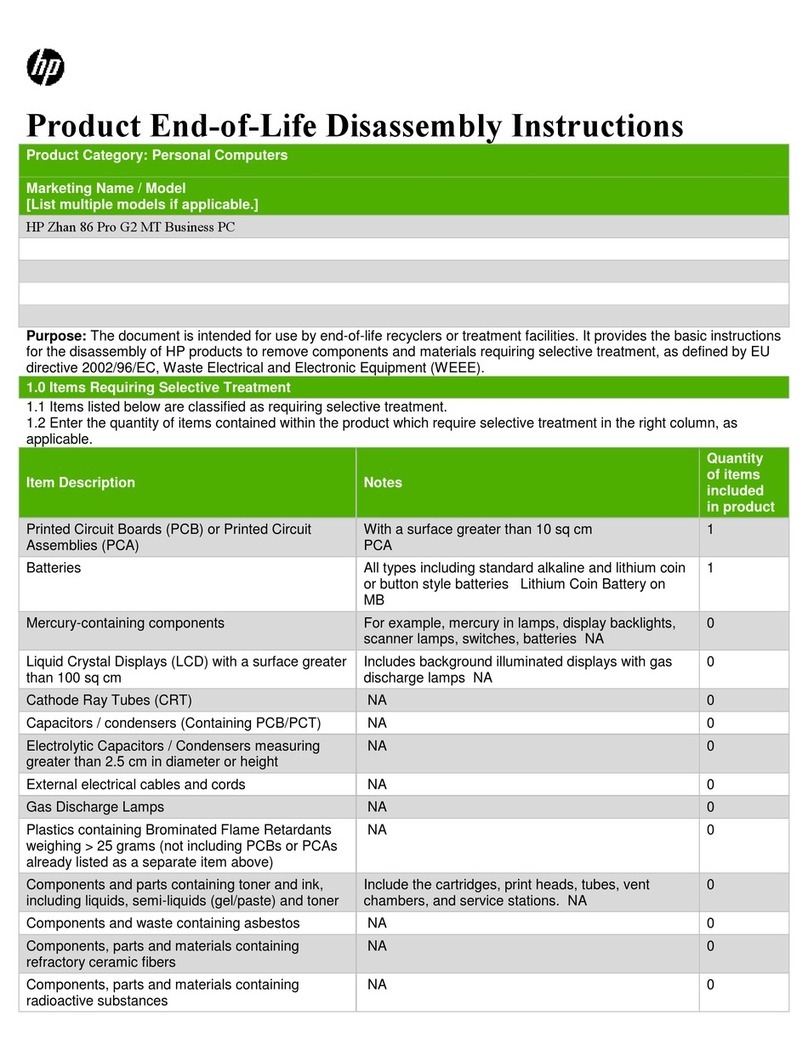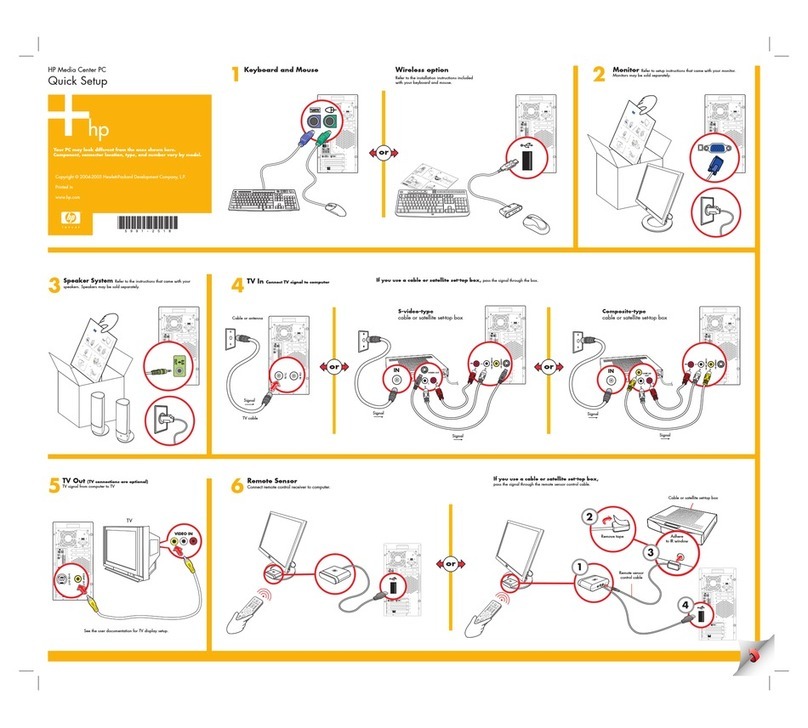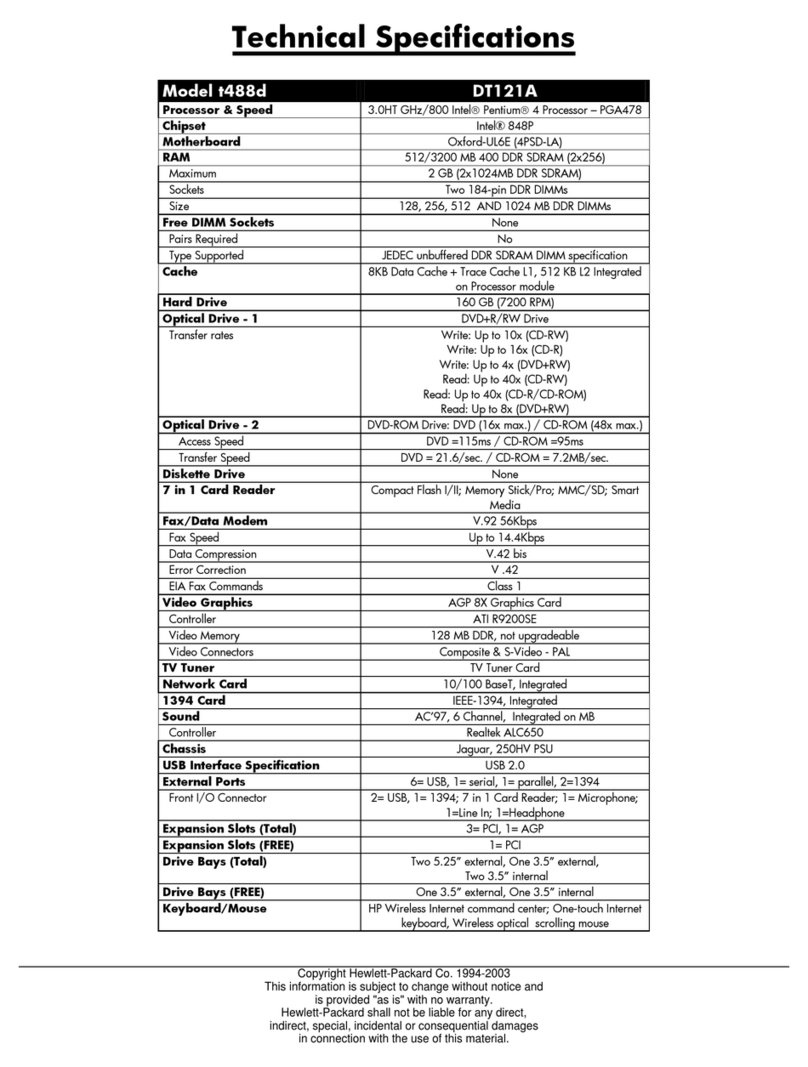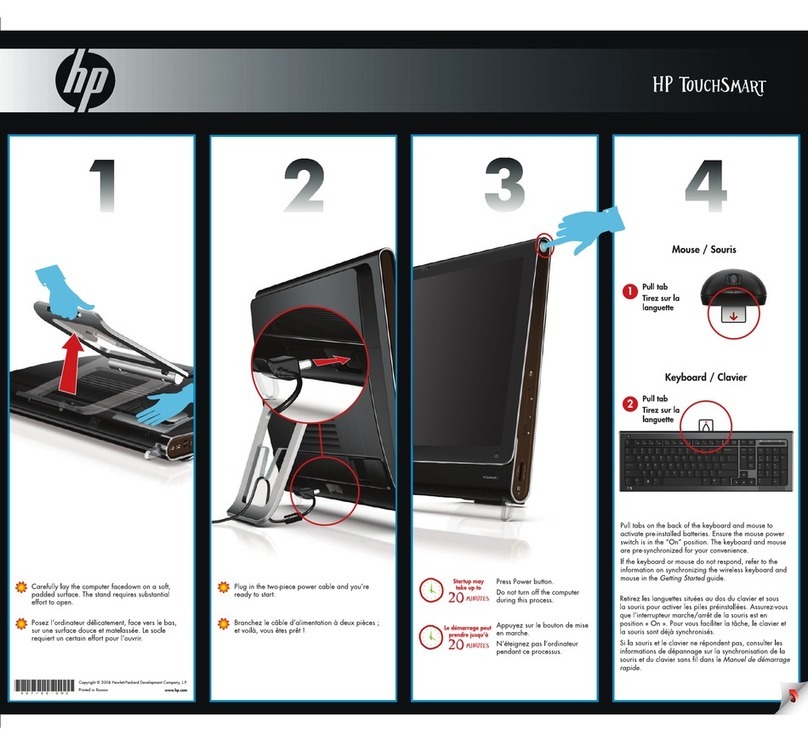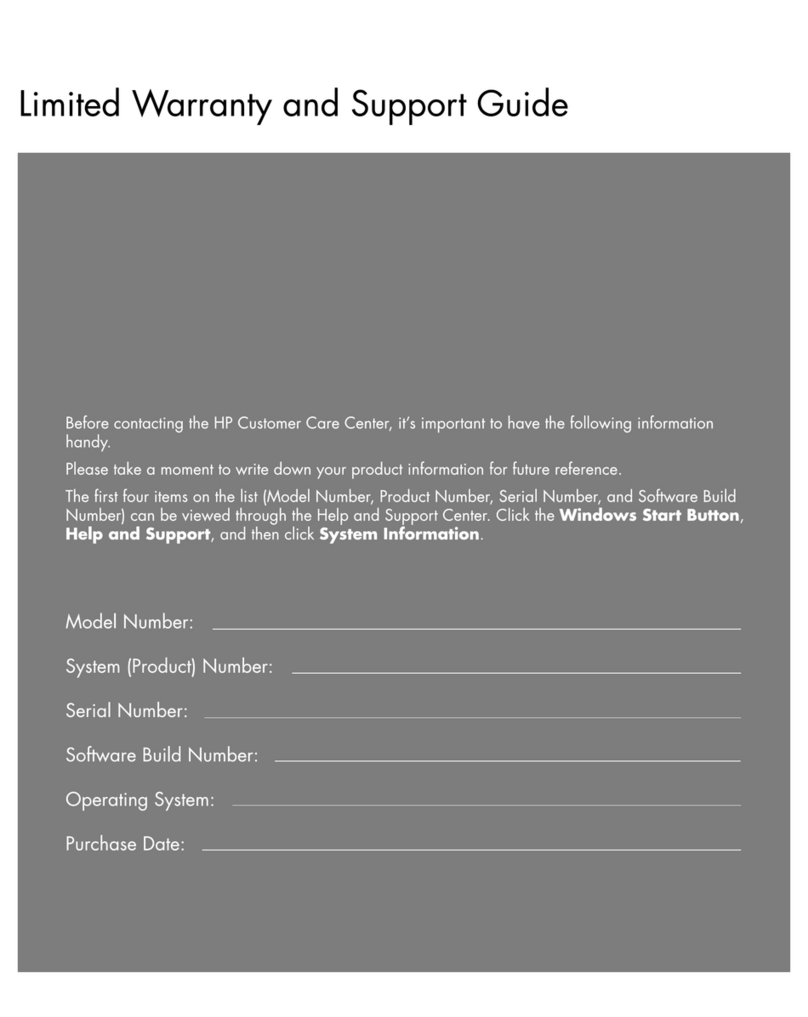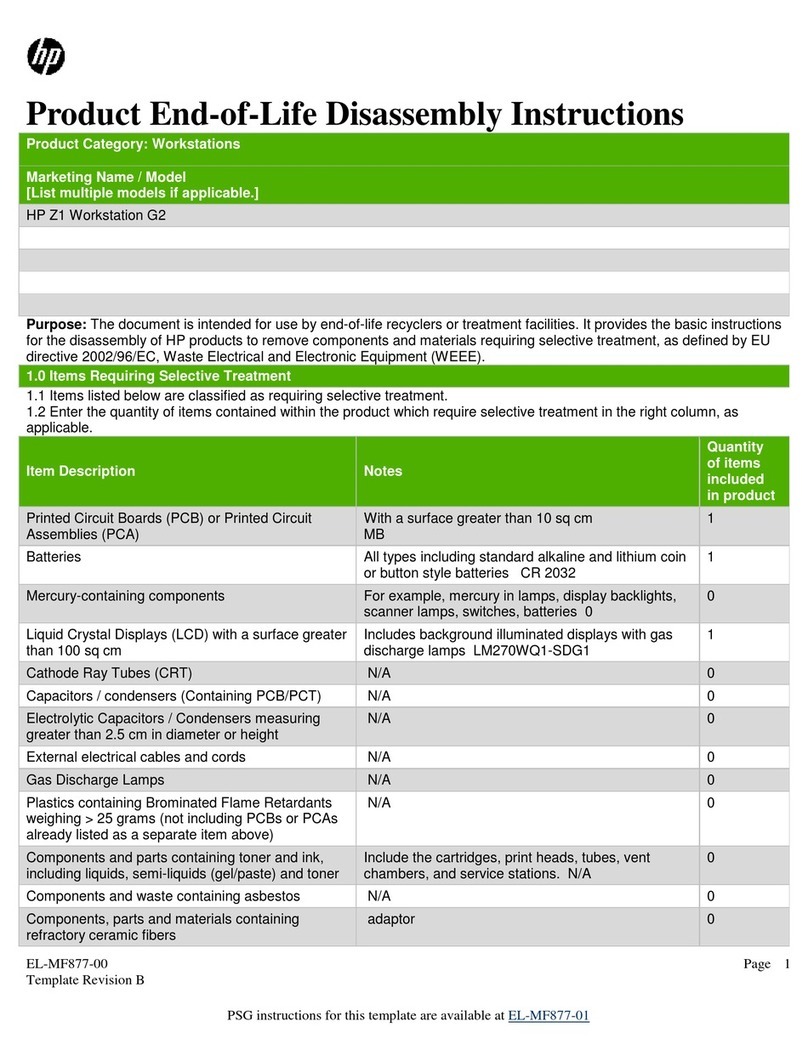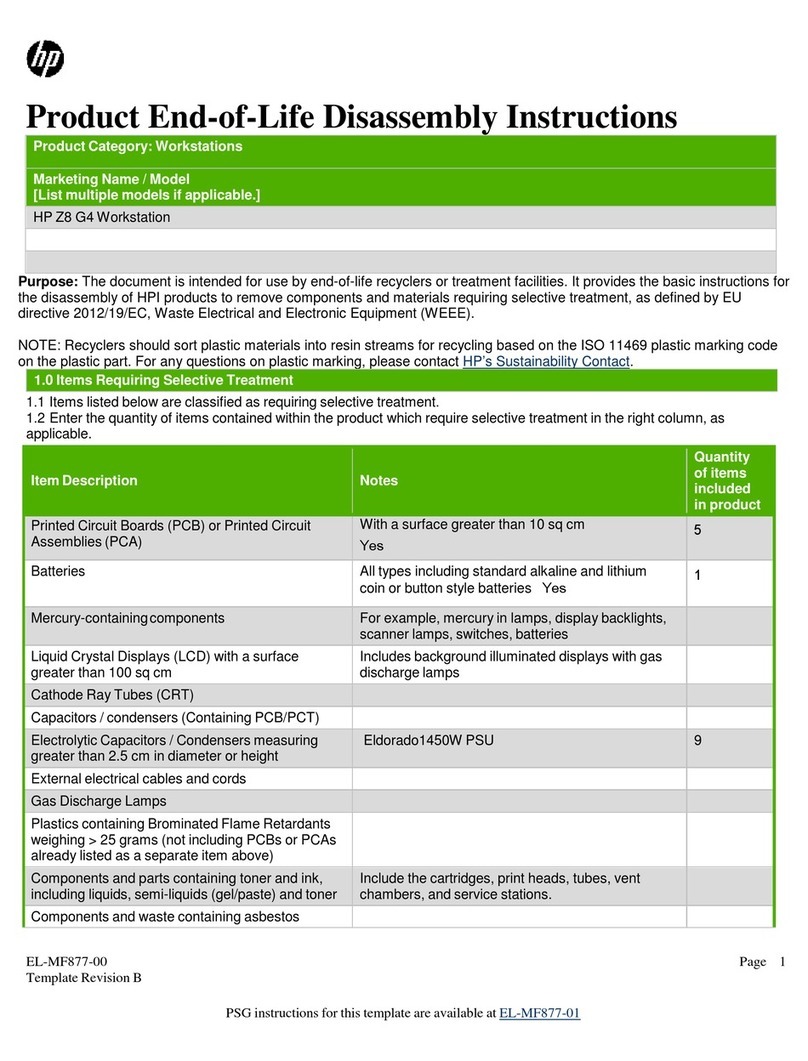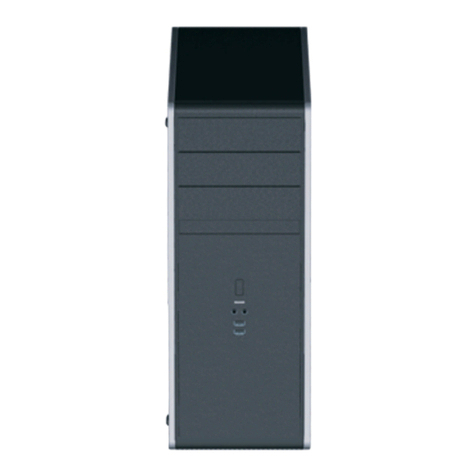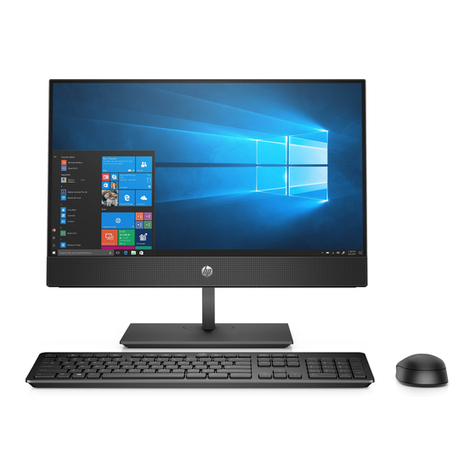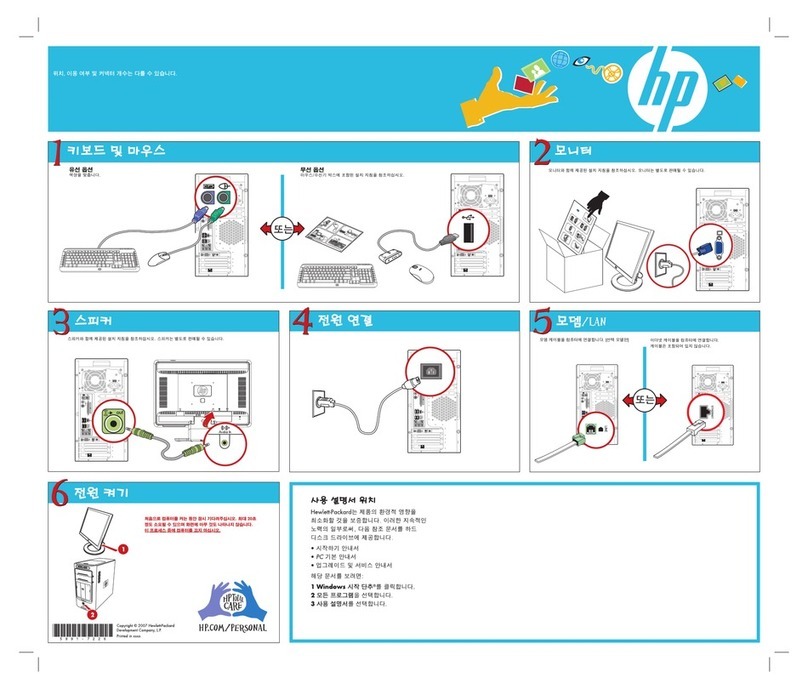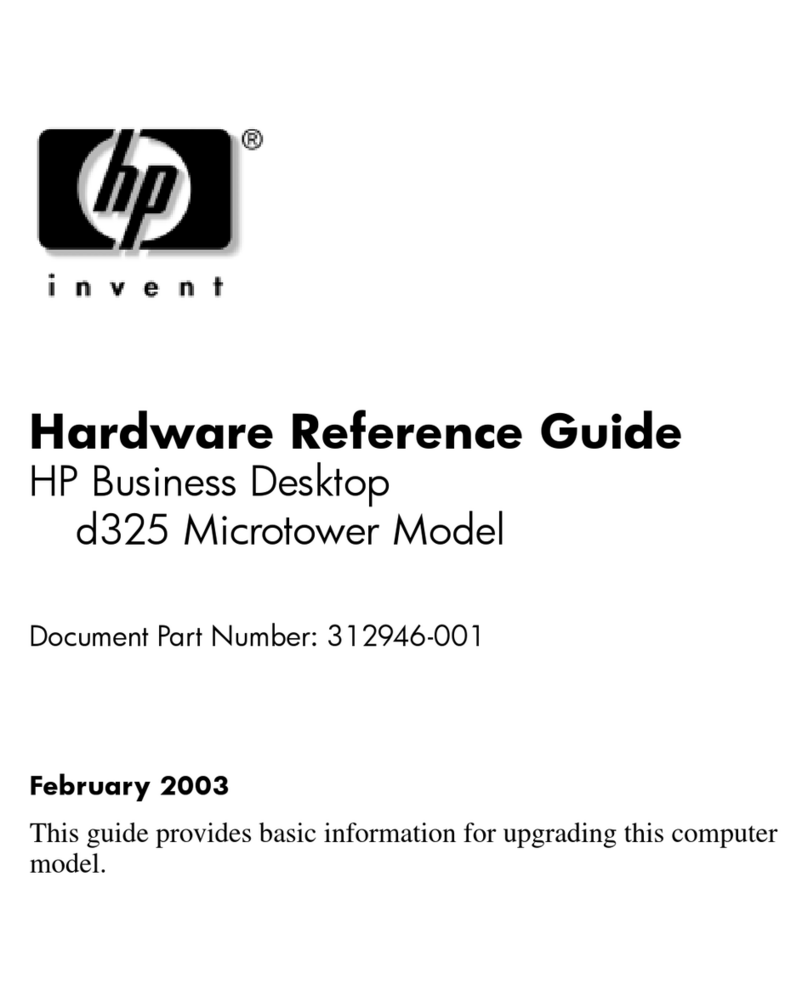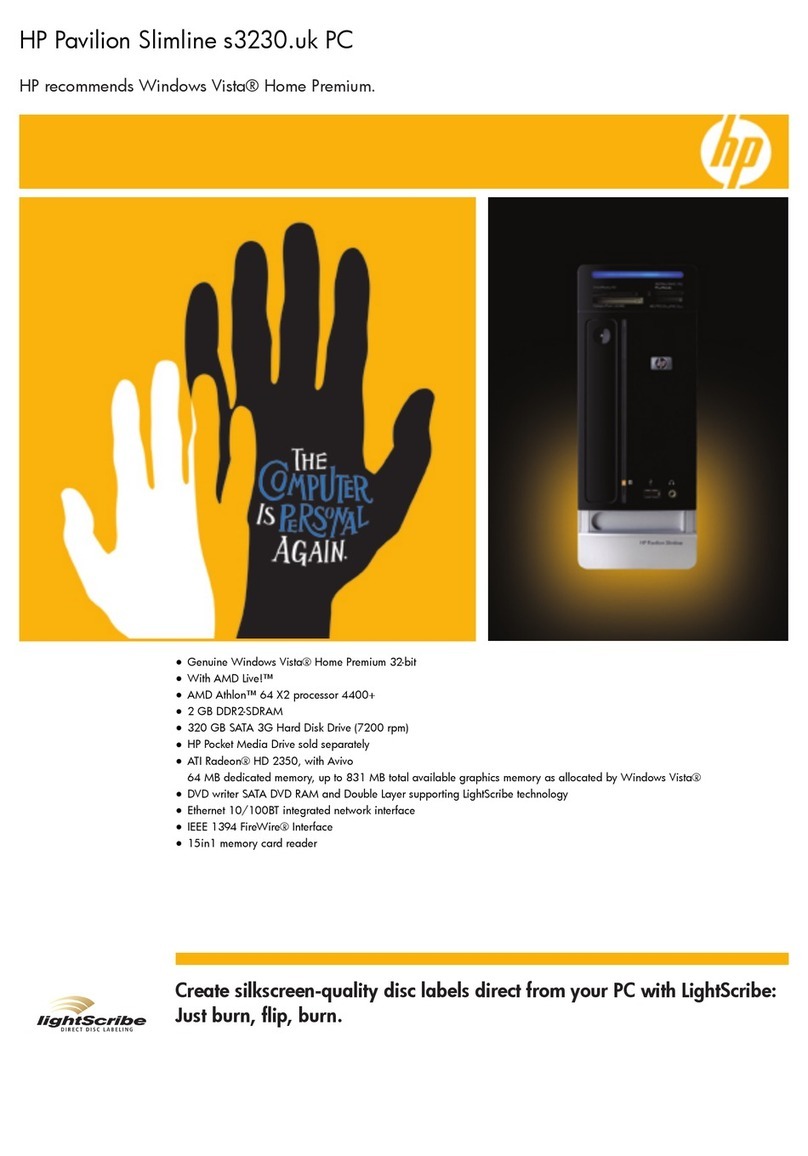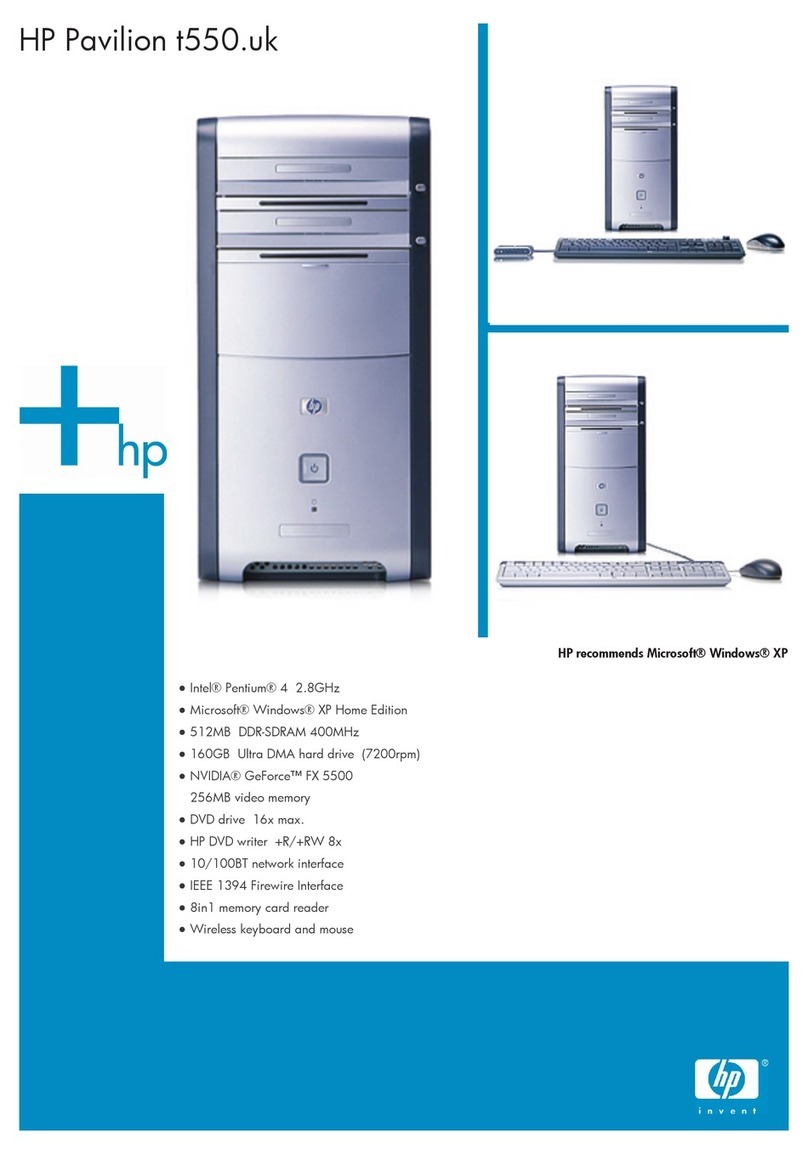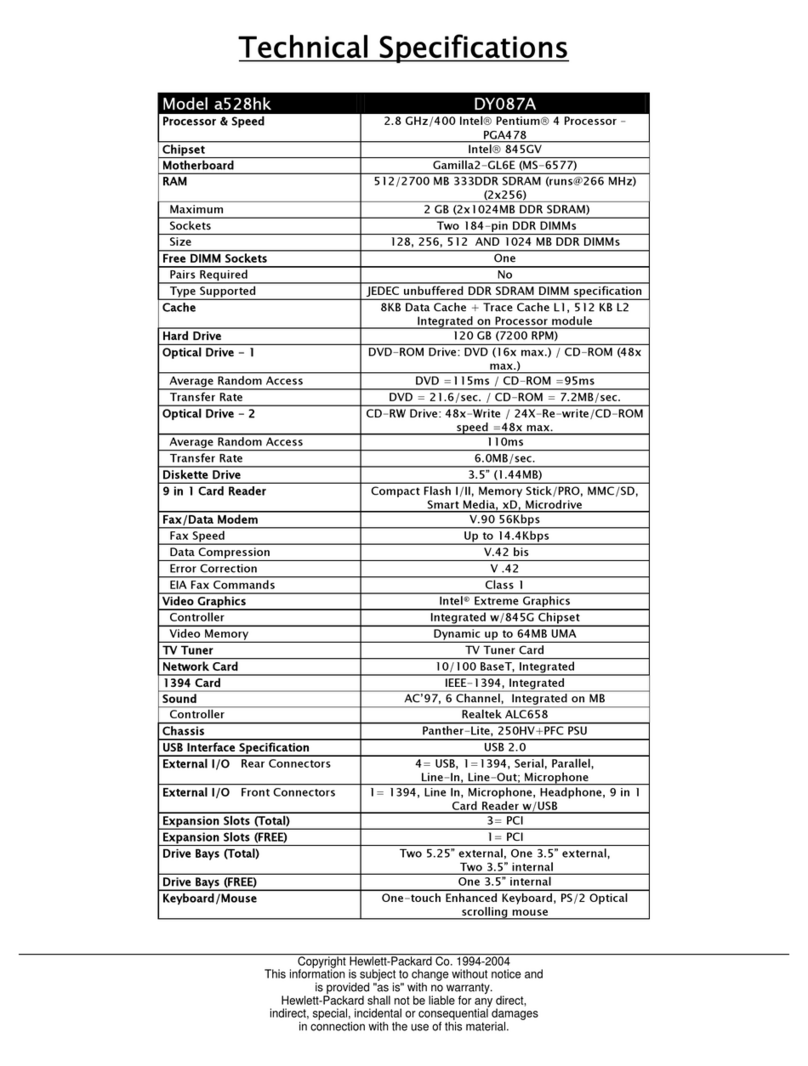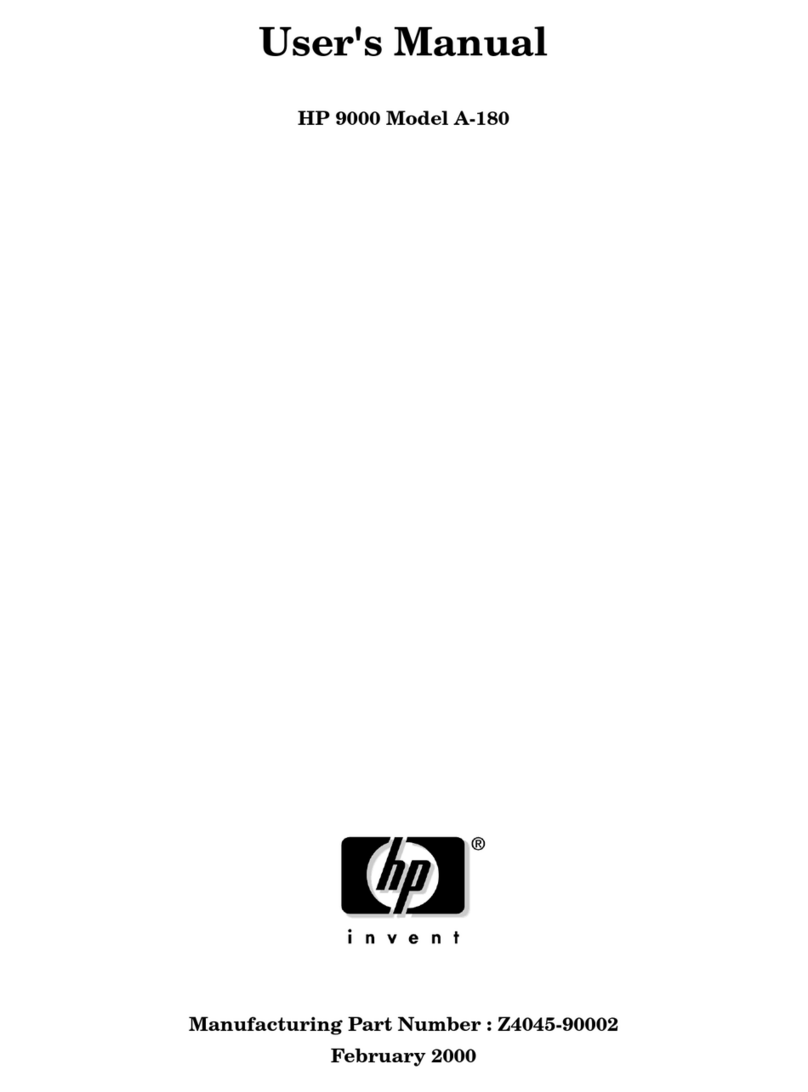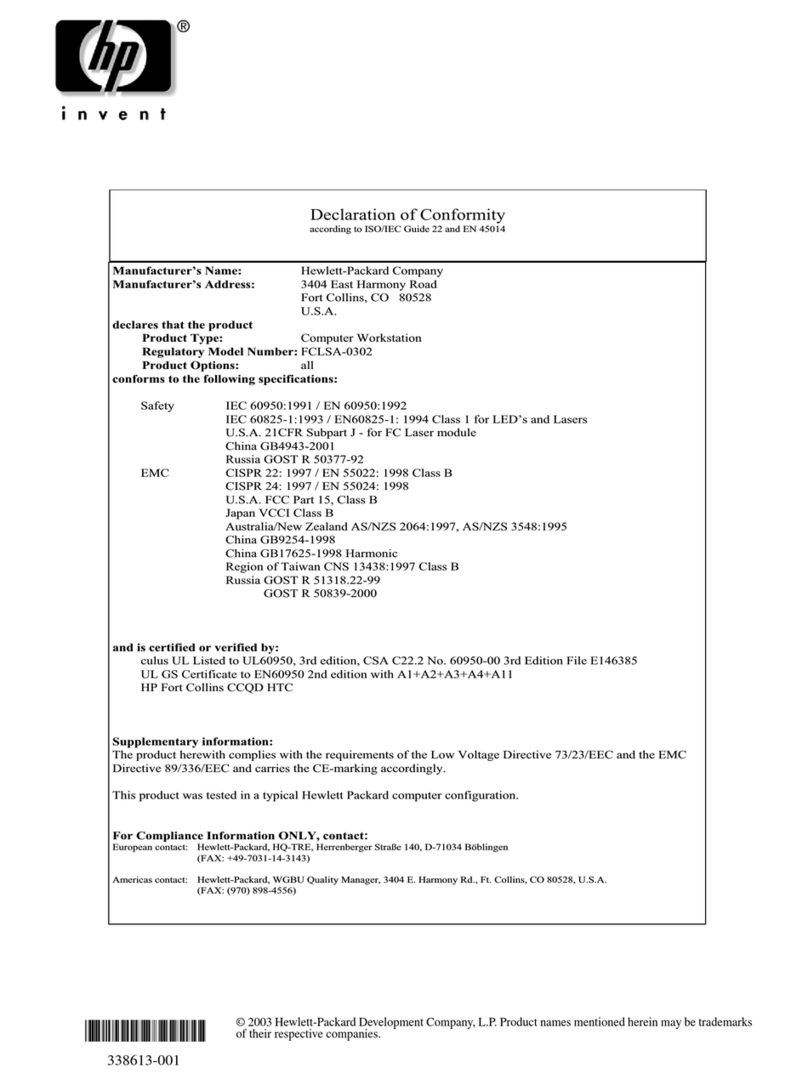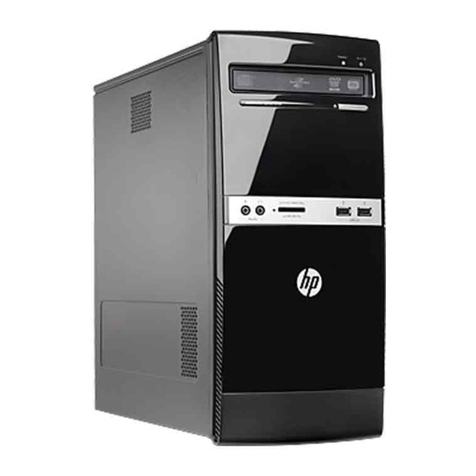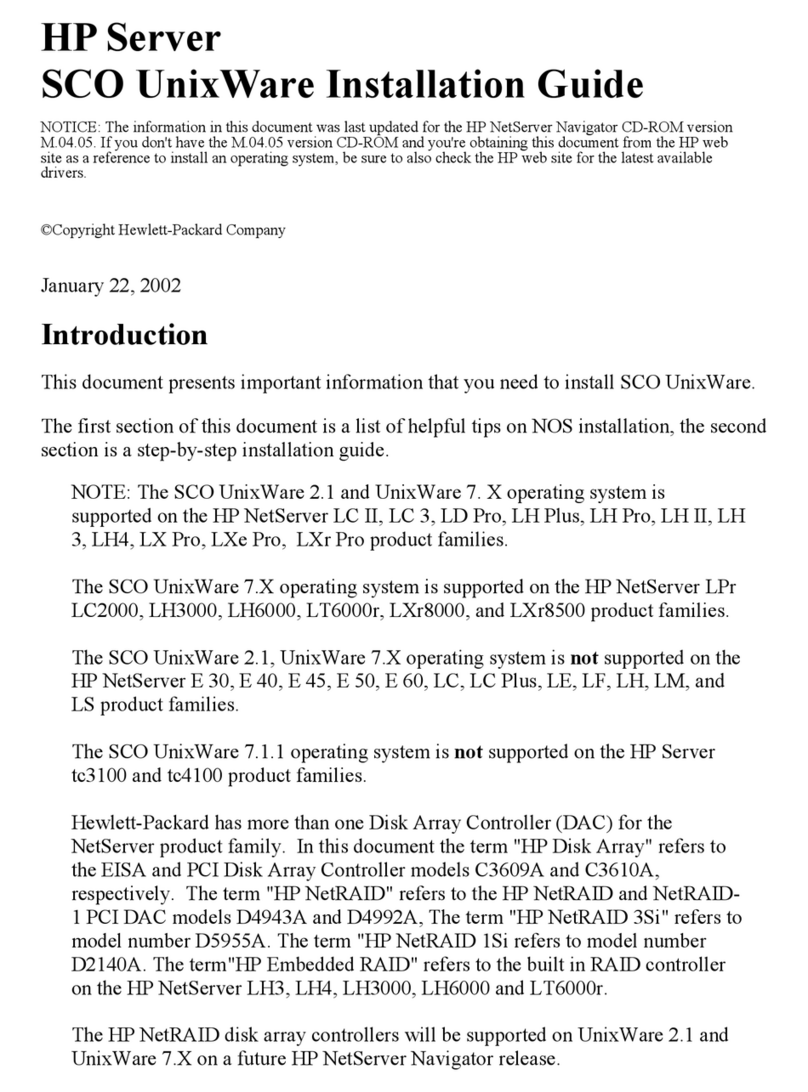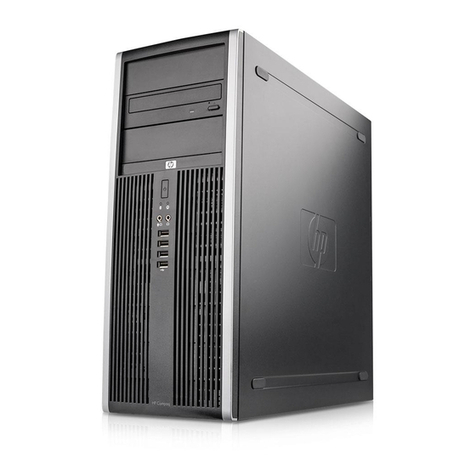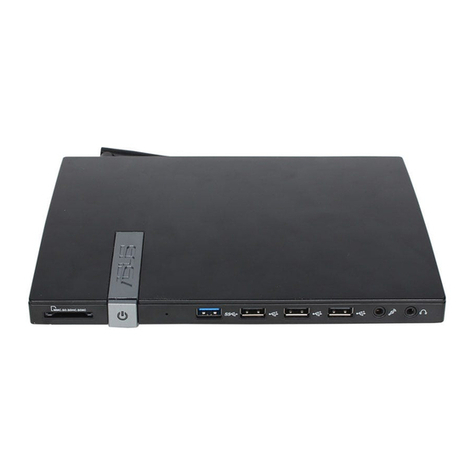
Service Reference Card
HP Compaq dc5100 Series Personal Computers
© 2004 Hewlett-Packard Development Company, L.P. The information contained herein is sub-
ject to change without notice. HP shall not be liable for technical or editorial errors or omissions
contained herein. Intel, Pentium, Intel Inside, and the Intel logo are trademarks or registered
trademarks of the Intel Corporation and its subsidiaries in the U. S. and other countries.
Document Number 376223-001. 1st Edition January 2005
Key Specifications
*You can connect a PATA hard drive. However, HP does not recommend its use .
System Setup and Boot
Basic system information regarding file, storage, security, and power configuration is main-
tained in the Setup Utility held in the system ROM. The Setup Utility is accessed by pressing the
F10 key as soon as the computer is turned on. If the screen prompt opportunity is missed, a
restart will be necessary.
Failsafe Boot Block ROM
The computer comes with a reprogrammable flash system ROM (read only memory).
NOTE: No USB device of any type will function during bootblock recovery.
To upgrade the ROM, you may:
a. Order an upgraded ROMPaq diskette from HP.
or
b. Download the latest ROMPaq images from the HP Web site (www.hp.com).
All ROM images used with HPQFlash and SSM are digitally signed to ensure authenticity and
minimize potential corruption. Your system ROM includes a Failsafe Boot Block that is pro-
tected during the flash process and allows the computer to be restarted in the unlikely event of an
unsuccessful ROM flash.
If the system detects an invalid system ROM during the boot sequence the system will sound
one long and three short beeps, flash the three keyboard LEDs twice, and display a recovery
mode message on the screen. To recover from the Boot Block recovery mode complete
the following steps:
1. Remove any diskettes from the diskette drive and turn off power.
2. Insert a ROMPaq diskette into the diskette drive or a bootable CD-ROM into an IDE CD-
ROM drive. (Bootable ISO CDs are available on the Web at www.hp.com.)
3. Turn on power to the system.
4. If a Setup password has been established, the Caps Lock LED will come on to prompt you for
the password. Enter the password.
5. A successful boot and ROM flashing (reprogramming) with a ROMPaq diskette is indicated
by the three keyboard LEDs turning on and a series of beeps rising in tone.
Security Functions
The system offers independent Power-On and Setup passwords for system and data protection.
The Power-On password protects the computer from unauthorized access by prompting the user
for a password during power up. The Setup password protects the computer from unauthorized
or inadvertent reconfiguration of legacy device resource settings or ROM flash upgrade by
prompting the user for a password prior to entering the Setup Utility.
To establish a password:
1. Turn on or restart the computer. If you are in Windows, click Start > Shut Down >
Restart the computer.
2. As soon as the computer is turned on, press and hold F10 until you enter Computer Setup.
Press Enter to bypass the title screen, if necessary. If you do not press F10 as soon as the
computer starts, a restart will be necessary.
3. Select Security, then select Setup Password or Power-On Password and follow the
instructions on the screen.
4. Before exiting, click File > Save Changes and Exit.
Key Specifications
Processor Type: Intel Pentium 4 or Intel Celeron
RAM Type: DDR2 PC3200 non-ECC
Maximum RAM Supported: Up to 4 GB depending on the model
Expansion Bus: PCI 2.3, X1 slot
Graphics Adapter Integrated controller or PCI 2.3 support depending on
model
Hard drive interface: SATA*
I/O Interfaces: Serial (1 std, 1 optional), parallel (1), USB 2.0 (8),
diskette drive (1), audio (5: 2 front, 3 back)
Computer Setup Menu
Heading Option / Description
File System Information - Lists product name, processor type/speed/step-
ping, cache size, installed memory size/speed, no. channels, integrated
MAC for enabled or embedded NIC, system ROM/family name/version,
chassis serial number, and asset tracking number.
About - Provides copyright information.
Set Time and Date - Allows selection of system time and date.
Replicated Setup -Allows saving to and restoring from removable
media.
Default Setup - Allows both saving current settings and restoring factory
settings as defaults.
Apply Defaults and Exit - Applies currently selected default settings and
clears all passwords.
Ignore Changes and Exit - Exits Computer Setup without applying or
saving any changes.
Save Changes and Exit - Saves changes to system configuration and
exits Computer Setup.
Storage Device Configuration - Lists all installed BIOS storage devices. The fol-
lowing options appear when a device is selected.
Diskette Type (legacy diskette drives only) Identifies the
highest capacity media type accepted by the diskette
drive.
Drive Emulation (IDE devices only) Selects drive type
emulation for storage
Drive Type Emulation Options
ATA P I Z i p
Drive
None (treated as other), diskette
(treated as diskette drive).
ATA Hard drive None (treated as other), disk (treated
as hard drive.
LegacyDiskette No emulation available.
IDE CD-ROM No emulation available.
ATAPI LS-120 None (treated as other), diskette.
Default Values IDE/SATA
Multisector
Transfers
ATA disks only
Selects number of sectors transferred.
Options are disabled, 8, and 16.
Transfer Mode
ATA devices
only
Selects active data transfer mode.
Options are PIO 0, Max PIO,
Enhanced DMA, Ultra DMA 0, and
Max UDMA.
Translation Mode (ATA disks only) Selects translation
mode to enable the BIOS to access disks partitioned and
formatted on other systems and may be necessary for
users of older versions of Unix. Options are: Automatic,
Bit-Shift, LBA Assisted, User, and None.
NOTE: The translation mode automatically
selected by BIOS should usually not be changed.
Translation Parameters (ATA disks only) Allows you to
specify disk parameters logical cylinders (max. of 1024),
heads (max. of 256), and sectors per track (max. of 63)
used by BIOS to translate disk I/O requests. Fields are
visible and changeable only when drive translation mode
is set to User.
Storage
Options
Removable Media Boot. Enables/disables ability to boot
system from removable media.
Legacy Diskette Write. Enables/disables ability to write
data to legacy diskettes.
BIOS DMA Data Transfers. Controls the type of data
transfer used by the BIOS to fulfill read and write
requests. DMA is used when Enable is selected. PIO is
used when Disable is selected.
SATA Emulation.Specifies whether the SATA and PATA
controllers function as two separate or one combined
controller. Separate IDE Controller emulation is recom-
mended for Windows 2000 and XP. Combined IDE Con-
troller emulation is recommended for operating systems
that only support one IDE controller.
Computer Setup Menu
(Continued)
Heading Option / Description
Storage
(continued)
Storage
Options (ctd)
IDE Controller. Enable/disable.
Primary SATA Controller - Enable/disable.
Secondary SATA Controller - Enable/disable.
DPS Self-Test - Allows execution of the Drive Protection System (DPS)
tests on ATA hard drives capable of the SMART self-tests.
Boot Order - Specifies the prioritized order of potential boot devices.
Each entry may be included or excluded from consideration as a boot
source. Use F9 during POST to select a one-time override to the
boot order specified here.
Security Setup Password - Enable/disable setup (administrator) password.
Power-On Password - Enable/disable power-on password.
Password Options (appears if Power-On or Setup password is set) -
Enable/disable password for warm boot.
Smart Cover Lock (some models) - Enable/disable Smart Cover Lock.
Embedded Security - Enable/disable Embedded Security device. Reset
device to Factory Settings.
Device Security - Enable/disable serial/parallel/USB ports, system
audio, NIC (some models).
Network Service Boot - Enables/disables Network Service Boot.
System IDs - Allows setting of Asset and Ownership Tags, chassis serial
number, keyboard locale, and Universal Unique Identifier (UUID).
DriveLock - Allows assignment of master or user password for Multi-
Bay hard drive(s).
Data Execution Prevention - Enable/disable to prevent OS Security
breaches.
Master Boot Record (MBR) Security - Enable/disable BIOS MBR
change reporting and write-protection.
Save MBR - Saves backup copy of MBR of current bootable disk.
Restore MBR - Restores MBR to current bootable disk.
Power OS Power Management - Enable/disable processor voltage and fre-
quency reduction during run and idle times; ACPI S3 support.
Hardware Power Management - Enable/disable SATA bus and/or device
power management.
Thermal - Fan idle mode to control minimum fan speed.
Advanced
(advanced
users only)
Power-On Options - Select POST mode for QuickBoot, FullBoot, Full-
Boot every 1-30 days; Enable/disable POST messages; Enable/disable
option ROM prompt; Enable/disable I/O APIC mode; Select computer
state after power loss; Select wakeup boot source; Enable/disable POST
delay (for slow hard drives); Enable/disable ACPI/USB buffers; Enable/
disable NIC option ROM download; Enable/disable Hyper-threading.
BIOS Power-On - Set computer to turn on at specific time of day.
Onboard Devices - Set resources for onboard devices (serial/parallel
port or diskette controller).
PCI Devices - Lists currently installed PCI devices and IRQ settings.
Allows configuration/disabling of devices (no effect on APIC systems)
Bus Options - Enable/disable PCI bus mastering, PCI VGA palette
snooping, PCI SERR# function, and ECC on select systems.
Device Options - Set printer mode (bidirectional output only); Num
Lock State;Wake-up events; processor cache; unique sleep state blink
patterns; integrated video; monitor tracking; NIC PXE Option ROM
download.
PCI VGA Configuration - Allows selection of VGA controller (if multi-
ple PCI video controllers are installed).
